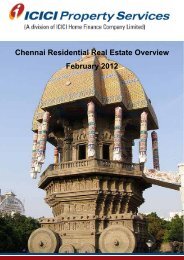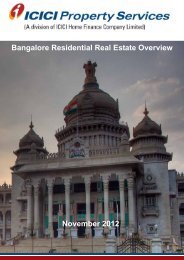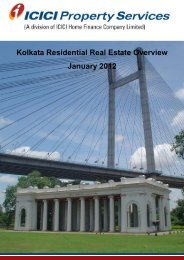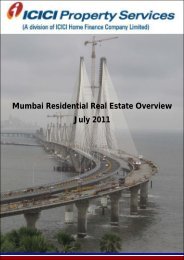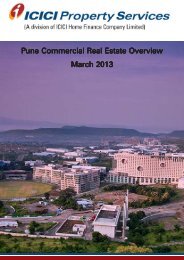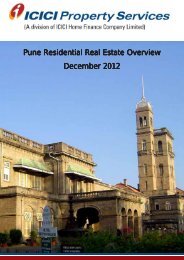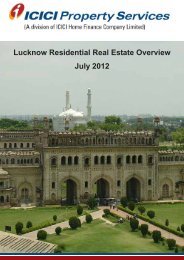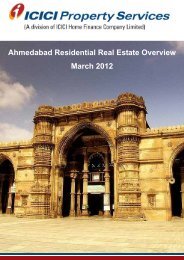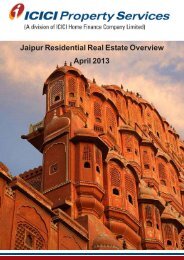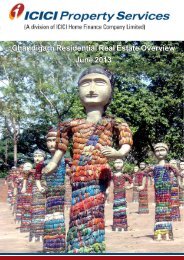Delhi Report - ICICI Home Finance
Delhi Report - ICICI Home Finance
Delhi Report - ICICI Home Finance
You also want an ePaper? Increase the reach of your titles
YUMPU automatically turns print PDFs into web optimized ePapers that Google loves.
CITY FACT FILE<br />
<strong>Delhi</strong>, the national capital of India, is situated in the northern part of the country and borders Uttar Pradesh to the east<br />
and Haryana on the north, west and south. The city is spread over an area of 1,483 square kilometers and 216 meters<br />
above sea level. Two prominent features of <strong>Delhi</strong>'s geography are the Yamuna flood plains and the <strong>Delhi</strong> ridge. The<br />
low-lying Yamuna flood plains provide fertile alluvial soil, which is suitable for agriculture but the planes are prone to<br />
floods. However, the <strong>Delhi</strong> ridge forms a dominating feature in the region. It starts from the Aravalli Range in the south<br />
and encircles the west, northwest and northeast parts of the city. Hindon river separates <strong>Delhi</strong> from Ghaziabad.<br />
The city boasts of its historical importance from the fact that it has been home to the Mughal Empire. The famous poet<br />
Mirza Galib describes the city as `the world is body and <strong>Delhi</strong> it's soul'. <strong>Delhi</strong> is also the political center of India.<br />
The name <strong>Delhi</strong> originates from the Persian word `Dahleez' (threshold of frontier) or from the name of the Mauryan<br />
king, Raja Dhillu. Some historical literature also refers to the original name as `Dhillika'. The satellite towns like Faridabad,<br />
Gurgaon and Noida collectively called the National Capital Region (NCR) surround <strong>Delhi</strong>. NCR was developed, as the<br />
city needed room to expand and bear the burden of the increasing growth and development in the region.<br />
Census 2011 Key Highlights<br />
Description 2011 2001<br />
Actual Population 16,753,235 13,850,507<br />
Male 8,976,410 7,607,234<br />
Female 7,776,825 6,243,273<br />
Population Growth 20.96% 46.31%<br />
Sex Ratio (females per 1000 males) 866 821<br />
Area km2 1,483 1,483<br />
Density/km2 11,297 9,340<br />
Literacy Rate 86.34% 81.67%<br />
Male Literacy Rate 91.03% 87.33%<br />
Female Literacy Rate 80.93% 75.24%<br />
Total Literates 12,763,352 9,664,764<br />
Male Literates 7,210,050 5,700,847<br />
Female Literates 5,553,302 3,963,917<br />
Source: Census 2011<br />
Gurgaon City:<br />
Overview:<br />
Gurgaon, located to the south of New <strong>Delhi</strong>, is the industrial and financial centre of Haryana. This satellite city was<br />
recognised as a potential investment destination, especially after the liberalisation of the Indian economy in the 1990s,<br />
owing to its proximity to New <strong>Delhi</strong> and the smart policy initiatives of the Haryana government. Today, modern shopping<br />
malls and skyscrapers dot its landscape after a major realty boom post the late 1990s.<br />
Geographical Stretch:<br />
The Gurgaon district comprises of five blocks: Badshahpur, Pataudi, Sohna, Gurgaon and Farrukhnagar. It is bounded<br />
by the district of Jhajjar and <strong>Delhi</strong> on its north, Faridabad district on the east and the district of Mewat in the south. On<br />
the west lies the district of Rewari and the state of Rajasthan. It is located at the northern edge of the Aravalli mountain<br />
ranges.<br />
4




